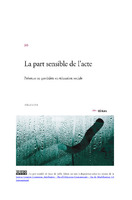La part sensible de l’acte
Author(s)
Libois, Joëlle
Collection
OAPEN-CH 1st Call; Swiss National Science Foundation (SNF)Language
FrenchAbstract
Social educators are involved daily in situations where institutional, profesional and personal elements are intermingled. To understand what is at stake in accompanying young people placed in a shelter, Joëlle Libois explores three profesional situations in order to reach the heart of the activity, enriching them by theoretical contributions (based mainly on Piette, Vygotski, Clot, Mendel). She particularly seeks to maintain coherence between the epistemology of the clinical approach to activity and the methodological building of her approach, and thus grasp the key dimensions of the acting. La part sensible de l’acte focuses on the intention in the action and questions it in the light of the epistemological framing of the analysis of activity, which insists on a dimension that is contextualised and situated in the acting. The activity is understood as an interaction between a manageable part of oneself and of the forces involved that proceed from the resistance opposed by the reality (Clot, 1999), which integrates what the will of the subject cannot grasp.
This allows to identify the standardized character of every practice and to insist on the fact that the relational – the notion of presence in reference to the notion of presence-absence (Piette, 2009) and the ability to to let go – is not linked to spontaneous virtues but that it needs being thought over, questioned and practiced in the frame of institutional targets.
At last, notions of uncertainty and risk, characteristic to the acting, are opposed to the institutional expectations carried by the normative speeches aiming for social control and evaluation of the action. Les éducateurs sociaux qui interviennent auprès de jeunes placés en foyer doivent naviguer entre des normes éducatives préconstruites et l’imprévisibilité inhérente à leur l’activité. Le quotidien, dans ses moments fantasques, place le professionnel à un degré élevé de complexité de l’agir. Prendre le risque que quelque chose puisse advenir, là où rien n’est attendu, se révèle comme axe fondateur de la pratique, là où précisément le geste spécialisé se perçoit difficilement. La part sensible de l’acte se penche sur cet agir professionnel et illustre comment les praticiens parviennent à relever ce défi. Joëlle Libois s’attelle à rendre dicible l’expertise dont relève le travail relationnel dans le quotidien du vivre ensemble. A l’aide de trois vignettes de situation en foyer pour jeunes, les pratiques quotidiennes qui engendrent du questionnement sont analysées ; là où le faire rencontre de la résistance, là où se posent des énigmes, là où se trouve un apport créatif dans la pensée.
Il s’agit de saisir ce qui fait acte dans le travail social, au travers de l’explicite et de l’implicite, de la sensorialité incarnée dans la mémoire des gestes comme dans la raison. Ces positions délicates d’intersubjectivité, de présence de soi aux autres, qui vise l’inclusion dans un univers porté journellement par les problématiques de l’exclusion, mettent en œuvre des savoirs professionnels qu’il importe de rendre visibles.
Keywords
intervention en travail social; jeunesse; formation / pédagogie; social work; activity analysis; pedagogy/training; analyse de l’activité; youth studiesDOI
10.26530/OAPEN_578318ISBN
9782882240996OCN
1030820424Publisher
Editions IESPublisher website
https://books.openedition.org/ies/Publication date and place
2013Series
Le social dans la cité, 20Classification
Social work


 Download
Download Web Shop
Web Shop